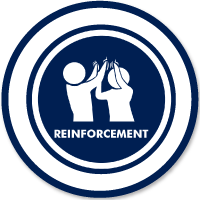
“I don’t get a candy bar every time I do my job, why should a client get something for doing what they are already supposed to do?” Have you ever thought or heard something like this when discussing positive reinforcement with clients in community corrections? When research shows positive reinforcement is more effective in long term behavior change, why is it that we tend to default to punish only?
In my experience managing clients, managing staff, being a mother, wife, mentor and coach, I can attest that it can be easier to sigh, moan and complain about the performance of others. Every time I find myself pulling out my hair, I realize I haven’t been using one of my best tools, positive reinforcement. And guess what, when I start using it (or increase my use of it), I see improvement and I feel happier. It is all too easy to only notice what is going wrong and completely pay no attention to what is going right.
Let me offer some tips for success when implementing a positive reinforcement program in your agency.
Positives & Punishers
Punishers are used to decrease negative behavior by either taking a privilege away or adding a consequence. Positives are effective in increasing positive behavior choices and making long term changes.
As many of you already know, research has shown that four positives to every one punisher (4:1) is the magic ratio when working with the justice involved population.
How Full Is Your Bucket?
I would recommend the book How Full is Your Bucket to anyone - Read this book! And those coaching staff and clients in community corrections to change can certainly benefit from this content. This book talks about the effect positivity can have in many areas of your life and how to decrease negativity. In this field, we can use all the positivity we can get and so can our clients.
The book touches on some researched based ratios of how often you should acknowledge something positive to negative in certain relationships. It was 3:1 in work-groups and 5:1 in marriages. That means if you tell your partner he never listens to you, you should also thank him for picking up the kids, vacuuming, helping clean up dinner, fixing the fan and turning in his paycheck this week (put your own spin on it).
So, if 4:1 is the magic ratio when working with the justice involved population, that means that the clients who are struggling the most with following rules and guidelines, need more positive reinforcement than the client who is doing great. Their bucket is empty, and it needs to be filled. Guess what, it is four times harder to find something positive in that client (coincidence?) so here within lies one of the challenges.
 Baby Steps
Baby Steps
For those difficult clients you may acknowledge them for making it to the meeting, a day of sobriety, clearing their breakfast tray, filling out a job application, opening a door for you, making it to and from an appointment without getting lost. These may seem minor to you but be huge accomplishments for them. In a halfway house setting, it may be an incredible challenge for a client to just return to the facility every single day or for a non-residential client to just report to your office. Think of all the work it takes when they don’t. The paperwork, checklist, the increased risk to the community. Saying good job and encouraging them is much easier than all that, it’s at least worth a shot.
We talk to community corrections agencies around the country and have found most programs are doing some sort of positive reinforcement programming. Whether it be as simple as noting what they told the client they are doing well in a meeting, to tracking the 4:1 ratio, or allotting points to specific behaviors and implementing a full blown reward management system with monetary and/or non-monetary rewards. A lot of times the staff feel negative about it when they don’t have effective tools to track the system and see it as just one more requirement set upon them.
Here are a few recipes for success when implementing a positive reinforcement and/or rewards management into your agency:
- Incorporate coaching and training to help staff understand the value this will bring
- Create a living culture of positive reinforcement with your staff and clients
- Practice what you preach – model this behavior with and for your staff
- Have staff brainstorm ways positive reinforcement has motivated them in their life/career
- Involve staff in finding ways to acknowledge the positive things in the more challenging clients
- Ask the clients for ideas on what recognition motivate them (and rewards if applicable - more effective to select rewards that motivate those earning them)
- Give your staff tools to easily manage and track the positives and rewards
- Track your program outcomes before and after implementing the program – see what is working for you
And next time you hear someone (or yourself) say that they don’t get something every time they do their job, remind them of their paycheck, PTO, positive work friendships and other benefits/incentives they may get but most importantly the respect, pride and enjoyment they get from doing a good job and hearing someone else say they are doing a good job. Those who get it tend to be the ones acknowledged with promotions, leadership roles and bigger awards (and employers who set this culture have more productive, happy employees). While it isn’t necessarily “a candy bar” it is positive reinforcement in the works. We are all motivated by positive reinforcement, it just comes in a variety of packages.
Want to learn more about coaching in community corrections? Check out our blog series on a Coaching Habit.


